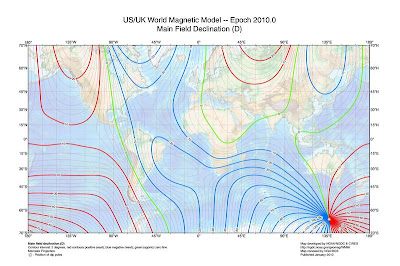It is important, when sailing to the Arctic Circle, to know where north is.
Traditionally the way to locate north (unless you have natural navigation skills) is the magnetic compass, though as those RYA courses tell you, you must check for variation and deviation.
Variation is a way of taking account of the fact that the magnetic north pole is not located at the Earth's physical pole. Up where we were it was around 20 degrees difference (as can be seen by the pic above from Wikipedia), though in addition the charts often had warnings of local magnetic anomalies.
Deviation is not what your grandma would call what you do on a Saturday night but rather how the ship's compass is being perturbed by ferrous materials and electronics on-board, and was probably similar to the variation.
Given the difference between actual north and compass north we relied a lot on the Raymarine chart plotter's COG (course over ground), which was great until it went into does-not-compute territory.
The problem was that over all the logs in one watch I noticed the COG was around 260 degrees i.e. something like WSW but at the same time the latitude was increasing.
This led to a lot of head scratching, as I'd imagine that COG was calculated using two (lat, long) points and a little spherical geometry, which is pretty straight forward.
So what was going on? Had we entered the mysterious "Iceland Triangle" or something?
To be honest I don't know. Another boat we met reported something similar with their Garmin GPS but the iThings seemed fine. Also sometimes we spotted the chart plotter jump between two GPS locations as if the other electronics was causing interference and that could cause problems.
All very weird.

5 comments:
While electronics are essential to our daily life, they remain a literal black box - you can't open them to observe the cogs and levers and perhaps get an idea of why something is not working right. Observing, tinkering, squirting a little oil, occasionally whacking give one a sense of being, if not in control, at least not totally at the mercy of machinery - but electronics and software remain totally aloof, reducing our ability to intervene to rebooting and a pushing buttons. Of course even if we could open them and see the source code it would be total gibberish. I am just as dependent as anyone else on electronics and would not want to be without them for even one minute - but the hermetic nature of their inner workings is frustrating.
There must have been some explanation.
1. Maybe the sample rate for the COG was longer than my patience at watching the latitude.
2. Maybe there was a weird sync between the two GPS values and the COG calculation
3. Maybe the GPS accuracy was lowered for some reason
4. Maybe there was a bug in the software
5. Maybe it had been set up to display course steered not over ground
6. Maybe it had been set up to display course magnetic not true
7. Maybe it was adding some leeway or current
8. Maybe....
I don't know - but wouldn't mind a read of the source code!
ok...would it be impertinent to ask what the Natural Navigator thought? Seems like this would be right about where he would become an incredibly good person to be sailing with - did he have any interesting things to keep an eye on that told you when the compass was probably roughly right and when it was not to be trusted?
I'll leave Tristan to cover that when he has time - he has lecture or two coming up (one on navigation unsurprisingly).
It was very reassuring to know that even if all the electronics failed we'd be ok.
If we'd had more time we'd have created a Viking sun compass.
Shoot, I wish you'd had more time!
Post a Comment